Revealed back in 2018 at Formnext in Frankfurt, the NXE400’s impressive-looking build is usurped only by the hype that surrounds it. According to Nexa3D, this next-generation 3D printer boasts three qualities that other manufacturers have struggled to balance: affordability, quality, and speed.
A large part of the Nexa3D NXE400’s magic is its special technology called Lubricant Sublayer Photo-curing (LSPc) and a patented structured light matrix that boosts printing speeds up to a zippy 1Z centimeter per minute. From prototypes to dental parts, the 3D printer is engineered to pump out a batch of resin parts in a matter of minutes.
Starting at $59,950, the NXE400 is poised to be a game-changer in the additive manufacturing world, providing engineers and designers with an efficient and remarkably fast machine capable of printing parts with SLA-like details and thermoplastic-grade mechanical properties.
To find out whether this lightning-fast machine is all it’s billed to be, All3DP visited Nexa3D and conducted a hands-on review of the NXE400 with the guidance of Nexa3D co-founder, CEO, and additive manufacturing legend Avi Reichental and COO Izhar Medalsy.
Basic Overview of the Features
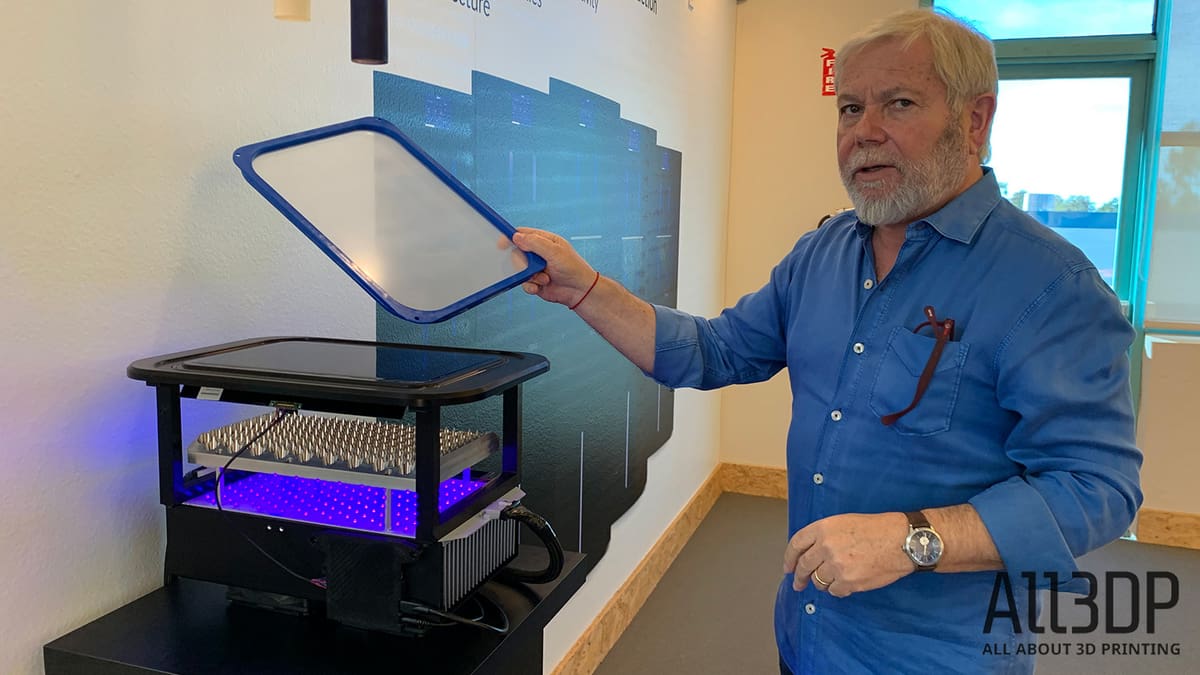
Before we get into the hands-on review, you might be wondering why there’s so much hype around the Nexa3D NXE400 in the first place. By using its LSPc technology, this resin-based system is able to churn out large parts at six times the speed of other competing 3D printers – all without sacrificing part quality.
When Reichental and his team launched Nexa3D, they did so with the goal of creating more than just another DLP machine. They wanted to devise a technology that offered better speed, print size, and resolution. To do this, Nexa3D had to overcome the constraints of resin-based 3D printing, including edge-to-edge uniformity, improving print speed while being able to print solid cross-sections, as well as pumping out resin-based prints that offered the mechanical strength of manufactured thermoplastics.
“The most important one, is how do you create, instead of an inhibition zone, more of a chemical interface and reaction zone that allows new chemical systems to create the kind of mechanical strength and feature detail performance, and high-temperature performance, and also useful shelf life that engineers and manufacturers expected from engineering-grade plastics,” said Reichental.
Nexa3D envisions a world with the NXE400 where spare parts can be printed on demand for customers at their local hardware store, where manufacturers can speed up their process and where automotive and aerospace industries can upgrade their speed, performance, and capacity.
The Nexa3D NXE400 has a 16-liter build volume, measuring out to 280 x 165 x 400 mm (11 in x 6.5 in x 15.74 in). The heart and soul of the NXE400 is the flexible membrane and next-generation light engine that employs LCD technology and powerful LED lights.
With its proprietary UV light array, the Nexa3D NXE400 is capable of complete light uniformity across the entire build area. This light engine projects 3D slices up into the resin vat where the proprietary membrane sits.
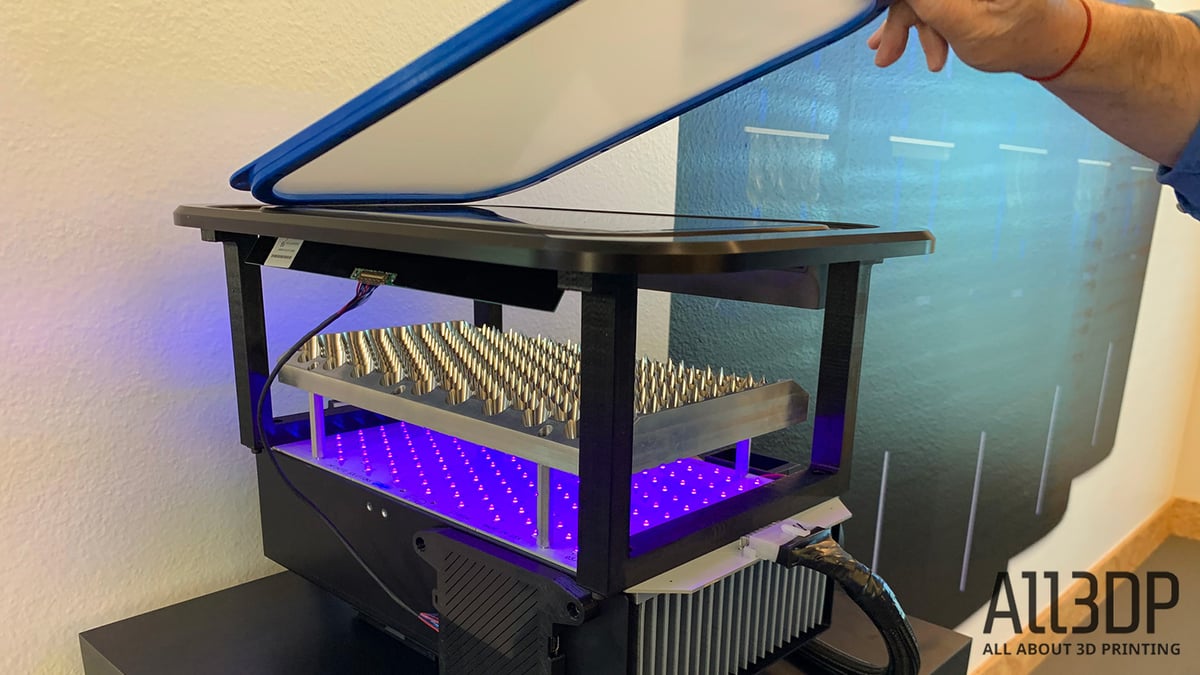
The self-lubricated membrane generates a no-stick zone in between the printed part and the resin vat, which is what enables the technology to print at such rapid speeds. Another factor that plays into this fast production process is the automated resin replenishment process, which delivers fresh resin across the entire print platform when needed.
“The light engine – because we have an array of very powerful LEDs – and the high transmission LCD allows us to bring enough power to cure the resins at the speed we need to know,” Medalsy told us. “The membrane, which has the unique chemical composition and combination allows us to relieve those forces, it’s inert with the resin but it’s also flexible so it responds to it.”
While there’s a lot to admire about this technology, there are three main features that set this printer apart: unprecedented speed, a large and uniform print volume, and the ability to print resins with thermoplastic-grade mechanical properties.
Fast Printing Speed
This printer boasts six times the speed of comparable printers on the market according to Nexa3D. They claim their machine can shorten the time needed to print prototypes and production parts from hours to mere minutes by continuously printing up to 16 liters of parts at 1Z centimeter per minute.
Large print volume
It’s not just supposed to be fast though, it can also handle bigger prints with its 270 x 160 x 400 mm build volume. Nexa3D claims this is two-and-a-half times larger than other comparable 3D printers on the market.
Capable of printing functional parts
Unlike other resin-based systems, the parts that the Nexa3D NXE400 can churn out aren’t just tchotchkes. It’s designed to print functional parts at injection molding quality, with comparable repeatability and tolerances. This is especially helpful for prototyping or if you require a one-off part that is either difficult to source or very expensive. Nexa3D envisions this technology in local hardware stores where it can quickly print out parts for customers, or for creating parts in the aerospace and automotive industries.
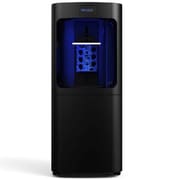

Software
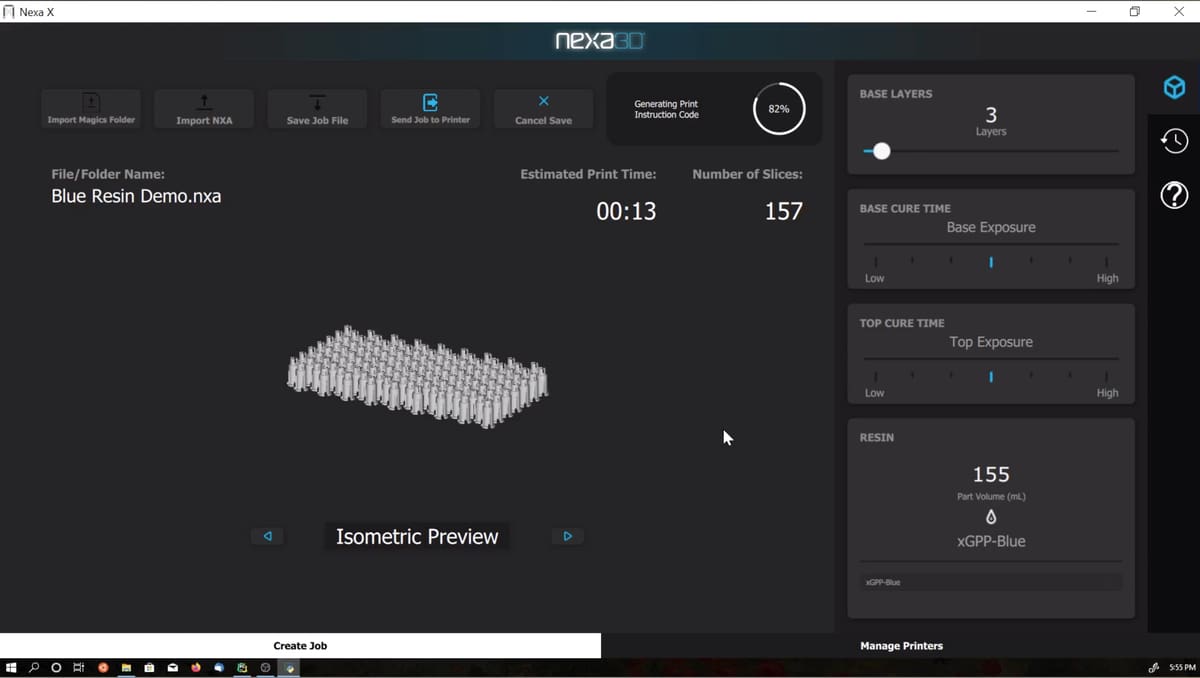
One of the most impressive parts of the Nexa3D workflow comes at the very beginning of the process – the Nexa X software.
Unlike most other slicers that inundate users with settings and options, Nexa X has an incredibly simple interface. On the top of the menu, users have the option to import and save files, send the print job to the printer, or cancel the job.
The right-hand side of the menu allows users to set a certain amount of base layers, select the base cure time and top cure time, as well as the resin that is being used. It’s extremely easy to switch between different settings and resins.
While this software doesn’t provide the full-fledged control of other slicers, there’s a reason for this. Nexa3D doesn’t want their customers to be concerned about finding the right settings, so all of that is taken care of for them.
“Machine operators, engineers, and designers have enough challenges in their daily work to solve real problems. The last thing we want is to turn them into expert operators in our technology,” said Reichental. “Our technology is there to serve them, not to enslave them.”
It all starts with importing the NXA file, Nexa3D’s version of an STL file. This file is prepared using Materialise Magics software, which has built-in integration with Nexa X. In a matter of seconds, the NXA file appears as an isometric preview in the center of the screen, where it can be rotated and scaled accordingly.
In our case, the virtual model displayed on the screen was the wide array of electric harness strain relief sleeves that we were preparing for the demonstration. The most time-consuming part of the software process is the preparation of the print instruction code, which essentially provides directions on how to print the model.
After that file is ready, users can select between available Nexa3D printers. Each 3D printer can be custom-named to differentiate between the others. When a specific printer is selected, the file is sent over via WiFi and the on-board camera inside of the printer’s build chamber is activated, providing a live look of the entire print process.
If there are multiple prints going on at once, users can oversee everything by clicking on the Overview tab. It’s also possible to send the same model to several 3D printers at once.
All in all, while not as flashy as the Nexa3D NXE400’s speed and accuracy, the software was one of the most intriguing aspects of the review experience. Like the hardware itself, the company clearly prioritized making Nexa X as intuitive and quick as possible.
3D Printing
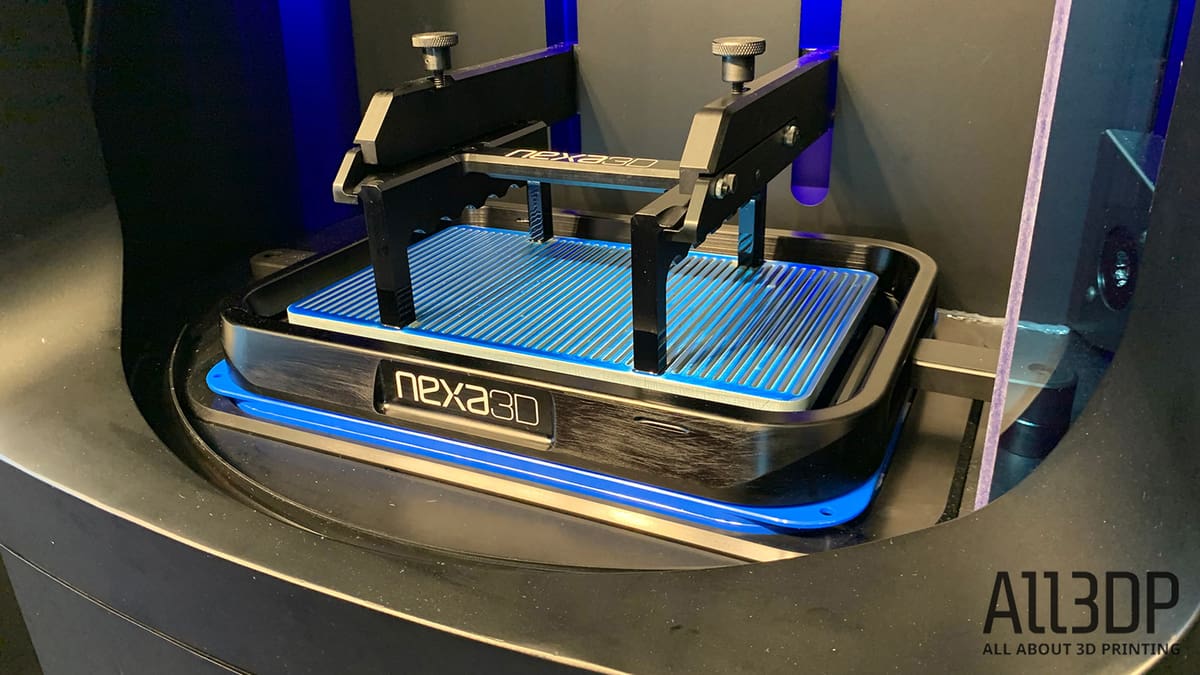
After we were given a tour of the Nexa3D office and met several members of the team, it was time for the demonstration. The process begins in Nexa X, the software described in the previous section.
From there, the model could be sent to the Nexa3D NXE400 located on the other side of the office via WiFi, another time-saving advantage that designers and engineers would salivate over.
To showcase the speed and efficiency of their 3D printer, Nexa3D choose to 3D print more than 100 electric harness strain relief sleeves designed for electric panels – all in one print cycle.

It seems likely that Reichental and the Nexa3D team selected this demo part for several reasons. Firstly, it contains an abundance of parts and covers the entire build plate, proving Nexa3D’s claim that their print is capable of edge-to-edge uniformity when it comes to print quality. The electric harness strain relief sleeves also provide a functional use case for potential customers, providing a relevant example of what the Nexa3D NXE400 can do.
While the part itself is relatively simple, we were printing approximately 125 of them. So, you can imagine our surprise when we sent the model over to the NXE400 and the apparent total print time was only around eight minutes. We’ve seen relatively fast resin-based 3D printers in our time, but nothing quite like this.
For the demonstration, Nexa3D had set us up with its xGPP Blue DRAFT resin, the fastest material from the Nexa3D selection. Admittedly, it’s unclear how long the printing process would have taken with another one of their materials. However, the speed of the machine didn’t seem to impede on the print quality.
While the printer was already set up once we arrived at Nexa3D’s headquarters, the team walked us through the general setup procedure for the hardware. In the bottom cabinet beneath the print chamber, there’s an area to mount the resin tank. Tubes are directed from the resin tank into the print area, automatically refilling the resin when the chamber needs replenishing.

After sending the 3D model to the NXE400, there wasn’t much manual labor left to do. Via WiFi, the printer was able to get started all on its own. The touchscreen display located at the top of the printer showcases the print progress. During our demo, we left the hinged print chamber enclosure open so we could get a closer look at the action.
Having reviewed different DLP machines in the past, watching the NXE400 print was like seeing the resin 3D printing process in hyperspeed. The printer started (and finished) printing over 100 parts in a matter of minutes, a truly remarkable thing to see in person.
While we waited for the demo print to finish, Reichental and Medalsy showed off some other prints produced by the NXE400. These sample prints included dental parts, detailed eagle heads in various materials, and automotive parts. Each print displayed a tremendous print resolution and represented a different segment that Nexa3D aims to satisfy.
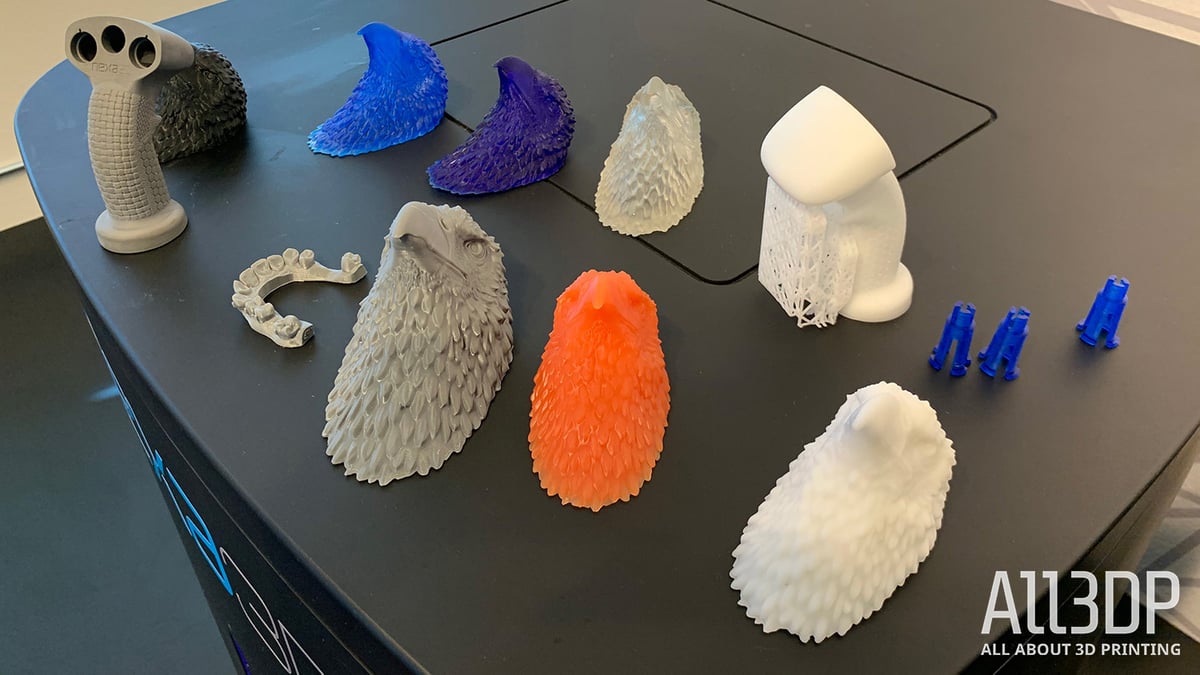
Now, it’s important to note that we didn’t have the opportunity to test out the mechanical properties of these parts, so we can’t fully attest to Nexa3D’s boisterous claims of producing thermoplastic-grade parts. However, considering the various use cases that the company had on display, we’re inclined to believe that the NXE400 is the real deal when it comes to producing functional parts.
Post-Processing

After the sample prints were finished, we moved onto the post-processing stage. The Nexa3D team had set up a small station with a tray, gloves, and scraper. Although the washing and curing station was on display, the post-processing units were not yet functional. This was a slight disappointment.
According to Reichental, the washing and curing station, priced at $15,000, will be released to customers this summer, helping to expedite the most time-consuming portion of the 3D printing process. The company says the post-processing station is capable of washing and curing a build plate’s worth of parts in around 10 minutes.
The washing station is designed to automatically detect the part volume and decide how long the washing process should be. Similarly, the curing station detects the part geometry and allocation on the build plate to settle on the right intensity and light distribution.
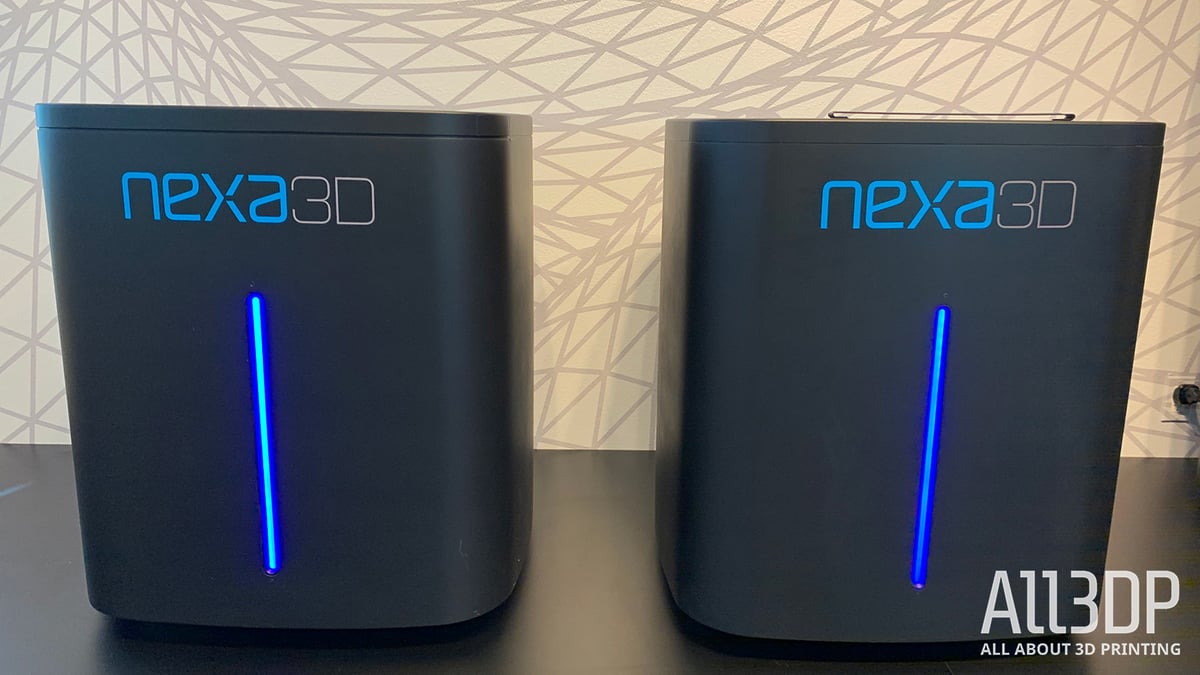
But alas, these systems weren’t ready for use, the Nexa3D team recommends curing 3D printed parts the old-fashioned way: by using isopropyl alcohol and natural sunlight. But first, we had to remove the parts from the build plate.
The perforated build plate made it incredibly easy to remove the collection of electric harness strain relief sleeves. Using a scraper, each 3D printed piece popped off the steel build plate without requiring much effort. The experience was akin to shaving a stubbly beard with an automatic razor, each small piece was quickly separated from the platform. To prove just how easy part removal was, Reichental implored us to use our hands and simply brush off the parts, and this worked just as quickly as the scraper.
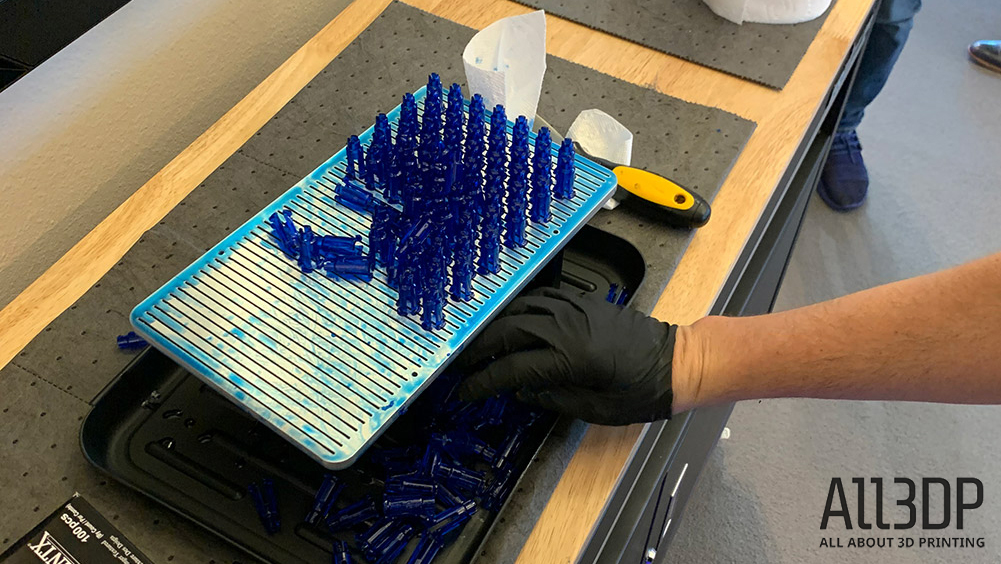
As we carefully but quickly scraped off the army of parts from the build plate into the tray, we could immediately notice the part quality and mechanical properties. Picking up each part (with the gloves still on) and looking past the blue residue, it was hard not to fawn over the fact that the NXE400 had produced over 100 high-quality parts in less than 10 minutes.
Materials
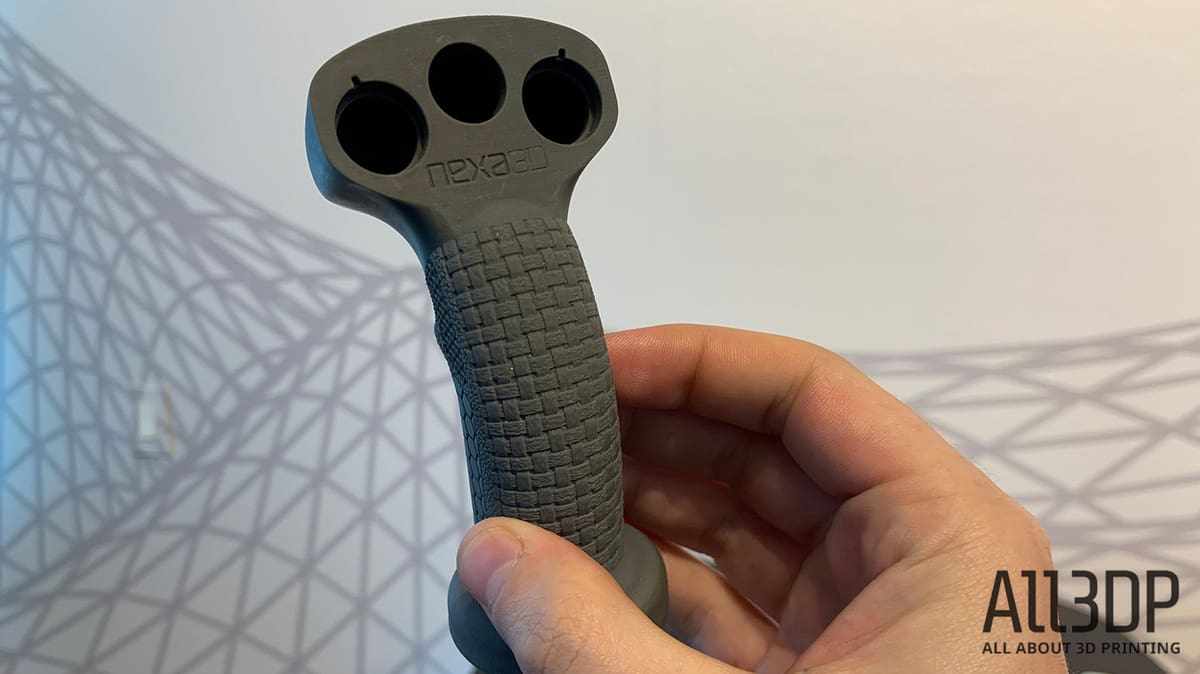
Currently, Nexa3D has a range of around 10 resins available for customers. These materials range from general-purpose resins to ABS and tough resins. According to Reichental, the company is planning to introduce dental resins and more performance-grade resins in the near future.
Working with a wide array of established and groundbreaking material producers, Nexa3D had to tailor these materials to work with its novel technology.
“We had to work with various chemical suppliers to tailor it for a system, now we’ve discovered we can actually tune their materials to perform even better than they anticipated,” said Reichental.
Unlike other resin-based 3D printers, the NXE400 is capable of producing parts with thermoplastic-grade properties because it is compatible with thermally-altered materials that can undergo a phase change.
That means we can take much more viscous materials that typically don’t work on resin 3D printers, elevating the temperature enough to put them into a controlled viscosity environment. In turn, the NXE400 is capable of printing resin materials and achieving mechanical properties akin to thermoplastics.
“What we’re excited about is that we’re bringing a new generation of materials to the market that will perform like thermoplastics in terms of mechanical strength and performance characteristics,” said Reichental. “In some cases, we believe they will even exceed what we see today with thermoplastics. It’s not science fiction, it’s just good science.”
Here’s an overview of some of the current material offerings from Nexa3D:
- xABS-HT-Orange: This functional material is ideal for injection molding molds, gauges, and fixtures. In the true fashion of ABS, it also supplies strong durability and low shrinkage, making it applicable for fully functional parts.
- xGPP-Translucent: A translucent material with low shrinkage and high-performance characteristics. Made for functional end-use parts and rapid iterations, this material is engineered for parts like air ducts and fluid flow models.
- xGPP-Gray: This resin offers high detail and a great surface finish, making it perfect for form, fit and function analysis, topology optimization studies, gauges, fixtures, and other industrial parts that require injection molding-like quality and durability.
- xGPP- Blue – DRAFT: The fastest material available in the Nexa3D ecosystem is capable of producing fully functional prototypes. It’s designed for form, fit and function analysis, topology optimization studies, demonstration and communication parts.
Conclusion
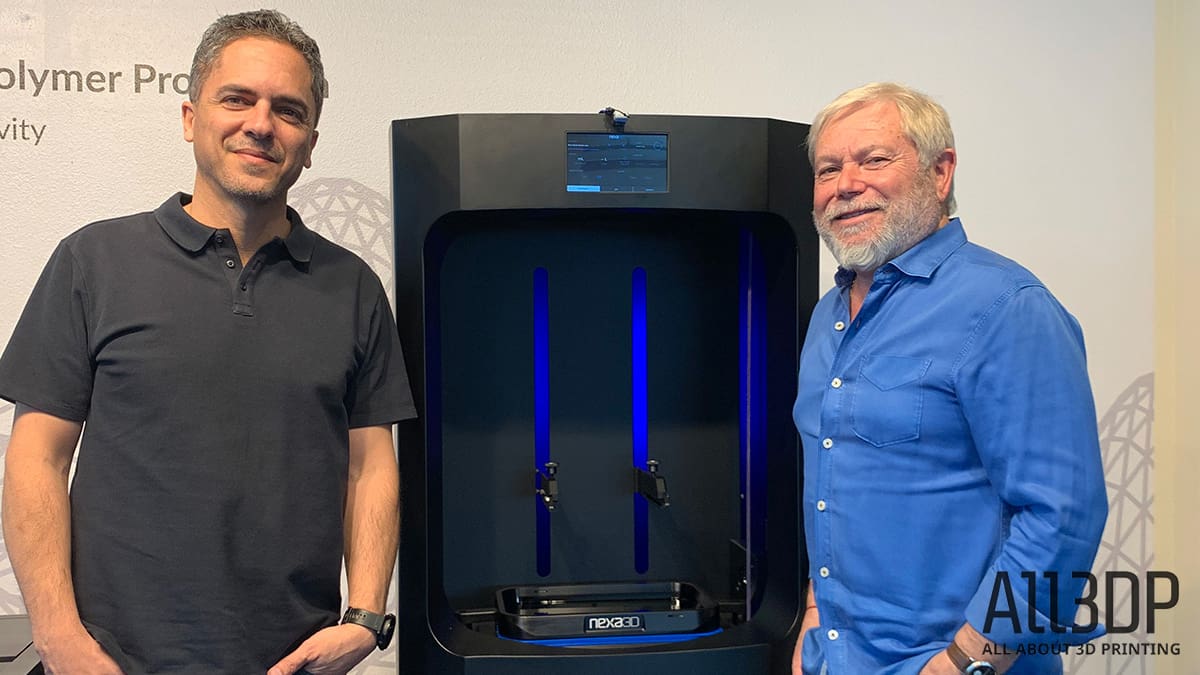
After our enjoyable visit to Nexa3D came to a close, we left impressed with the overall performance of the NXE400. What really stood out was the seamless workflow of the whole process, from the speedy and intuitive software to the easy removal of freshly printed resin parts.
Speed is obviously one of the main selling points, and the Nexa3D NXE400 proved itself worthy of the hype in this department. While the printing process was the highlight of the show, pumping out over 100 parts in a matter of minutes, the quickness extends to the software and post-processing as well. The entire system is engineered to be as fast and time-efficient as 3D printing can be (at this stage in the game, at least).
Print quality, considering the speed of the process, was also noteworthy. Although the demo parts we printed were relatively simple, the other samples on display showed impressive details comparable to other popular resin-based systems.
The technology that powers the NXE400 was also interesting to see up close. The powerful light engine and proprietary membrane work in tandem to set this printer apart from other professional resin-based systems. Having Reichental to lecture us about the innovative parts of the printer helped to put everything in perspective.
Now, there were some reasons to be cautious with our admiration for the Nexa3D NXE400. As mentioned, we didn’t have the chance to test the functionality of these prints once they were cured, nor did we get to use the new washing and curing station. When we arrived, the printer was essentially ready to go, so we didn’t get a feel for the hardware setup.
This doesn’t detract from the incredible features of the Nexa3D NXE400, however. It’s one thing to read about a machine that can produce a hundred parts in less than 10 minutes, but another to see it happen in person.
All in all, as Reichental, Medalsy, and their team continue to expand their knowledge and customer base, we expect to see Nexa3D rise through the ranks and become the game-changing technology that it claims to be.


Tech Specs
GENERAL
- Printing technology: Continuous LSPc
- Light source: Structured Light Matrix40
- Build volume: 280 x 165 x 400 mm (11 in x 6.5 in x 15.74 in)
- Z-layer resolution: 50/100/200 microns
- XY resolution: 75 microns
- UI: Predictive and prescriptive
- Connectivity: USB cable/USB drive/Ethernet/WiFi
- Build platform leveling: System is designed to not require bed leveling
- Materials: Nexa3D materials, including xABS-HT-Orange, xGPP-Translucent, xGPP-Gray, xGPP- Blue
SOFTWARE
- Software bundle: Proprietary
- File types: .stl, .3ws, .3wn, .step
WEIGHT AND DIMENSIONS
- Weight: 160kg (352lbs)
- Dimensions: 990 x 990 x 1905 mm (39 x 39 x 75 in)


License: The text of "Nexa3D NXE400 Review: Professional Parts in Minutes" by All3DP Pro is licensed under a Creative Commons Attribution 4.0 International License.